2020 Hyundai Tucson remove seats
[x] Cancel search: remove seatsPage 36 of 637
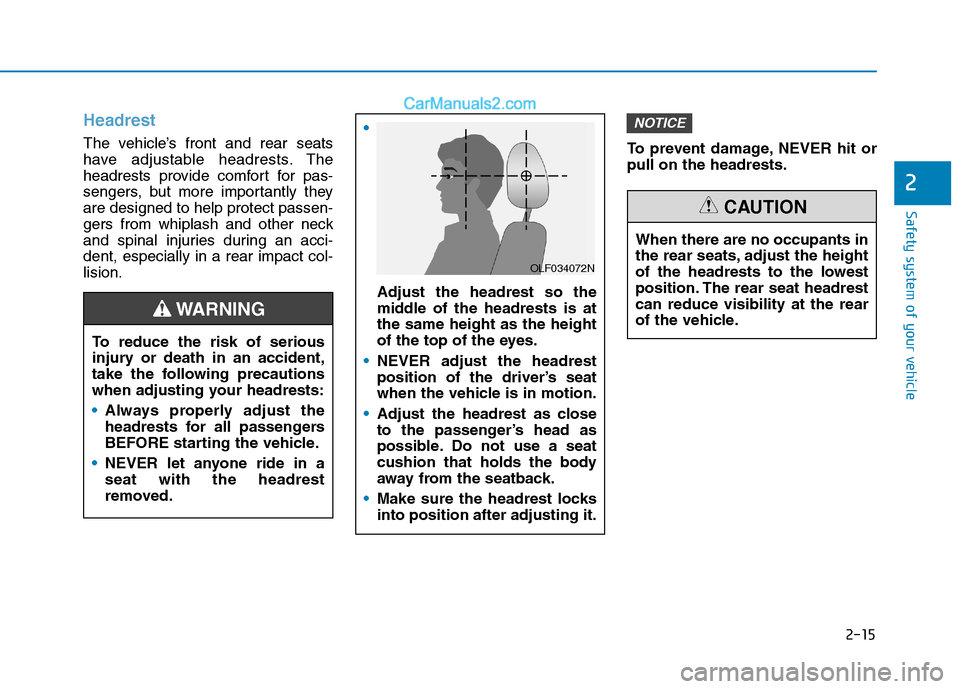
2-15
Safety system of your vehicle
2
Headrest
The vehicle’s front and rear seats
have adjustable headrests. The
headrests provide comfort for pas-
sengers, but more importantly they
are designed to help protect passen-
gers from whiplash and other neck
and spinal injuries during an acci-
dent, especially in a rear impact col-
lision.To prevent damage, NEVER hit or
pull on the headrests.
NOTICE
When there are no occupants in
the rear seats, adjust the height
of the headrests to the lowest
position. The rear seat headrest
can reduce visibility at the rear
of the vehicle.
CAUTION
To reduce the risk of serious
injury or death in an accident,
take the following precautions
when adjusting your headrests:
Always properly adjust the
headrests for all passengers
BEFORE starting the vehicle.
NEVER let anyone ride in a
seat with the headrest
removed.
Adjust the headrest so the
middle of the headrests is at
the same height as the height
of the top of the eyes.
NEVER adjust the headrest
position of the driver’s seat
when the vehicle is in motion.
Adjust the headrest as close
to the passenger’s head as
possible. Do not use a seat
cushion that holds the body
away from the seatback.
Make sure the headrest locks
into position after adjusting it.
WARNING
OLF034072N
Page 61 of 637
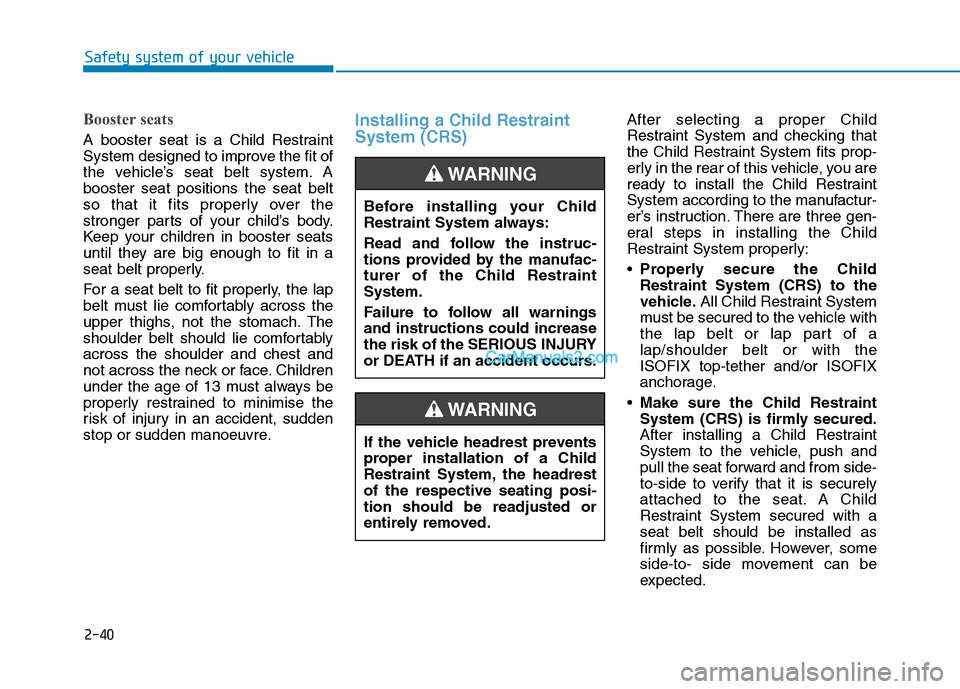
2-40
Safety system of your vehicle
Booster seats
A booster seat is a Child Restraint
System designed to improve the fit of
the vehicle’s seat belt system. A
booster seat positions the seat belt
so that it fits properly over the
stronger parts of your child’s body.
Keep your children in booster seats
until they are big enough to fit in a
seat belt properly.
For a seat belt to fit properly, the lap
belt must lie comfortably across the
upper thighs, not the stomach. The
shoulder belt should lie comfortably
across the shoulder and chest and
not across the neck or face. Children
under the age of 13 must always be
properly restrained to minimise the
risk of injury in an accident, sudden
stop or sudden manoeuvre.
Installing a Child Restraint
System (CRS)After selecting a proper Child
Restraint System and checking that
the Child Restraint System fits prop-
erly in the rear of this vehicle, you are
ready to install the Child Restraint
System according to the manufactur-
er’s instruction. There are three gen-
eral steps in installing the Child
Restraint System properly:
Properly secure the Child
Restraint System (CRS) to the
vehicle.All Child Restraint System
must be secured to the vehicle with
the lap belt or lap part of a
lap/shoulder belt or with the
ISOFIX top-tether and/or ISOFIX
anchorage.
Make sure the Child Restraint
System (CRS) is firmly secured.
After installing a Child Restraint
System to the vehicle, push and
pull the seat forward and from side-
to-side to verify that it is securely
attached to the seat. A Child
Restraint System secured with a
seat belt should be installed as
firmly as possible. However, some
side-to- side movement can be
expected. Before installing your Child
Restraint System always:
Read and follow the instruc-
tions provided by the manufac-
turer of the Child Restraint
System.
Failure to follow all warnings
and instructions could increase
the risk of the SERIOUS INJURY
or DEATH if an accident occurs.
WARNING
If the vehicle headrest prevents
proper installation of a Child
Restraint System, the headrest
of the respective seating posi-
tion should be readjusted or
entirely removed.
WARNING
Page 616 of 637
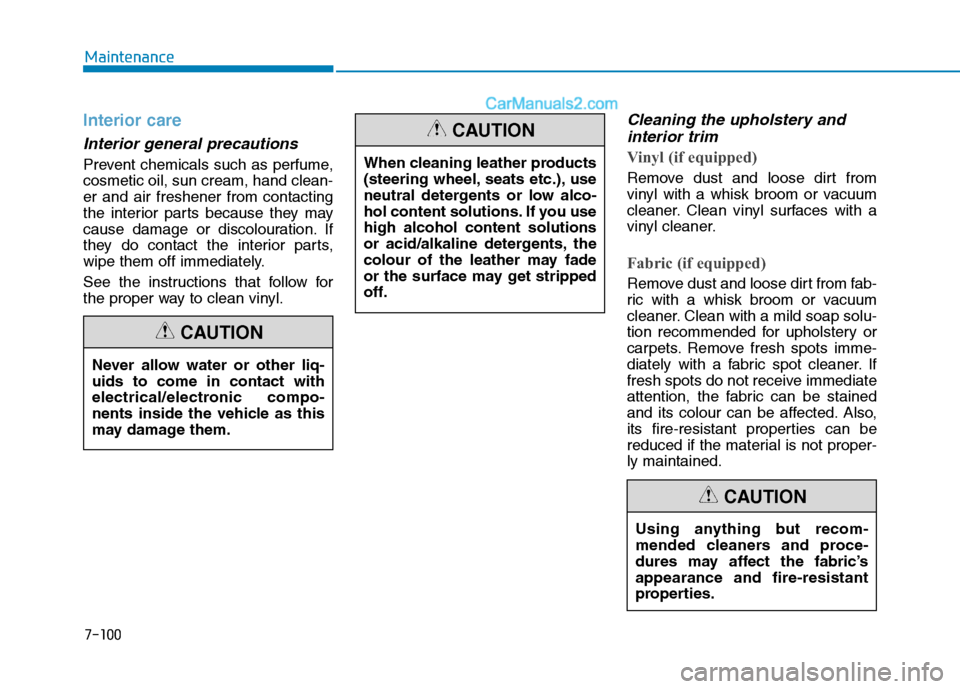
7-100
Maintenance
Interior care
Interior general precautions
Prevent chemicals such as perfume,
cosmetic oil, sun cream, hand clean-
er and air freshener from contacting
the interior parts because they may
cause damage or discolouration. If
they do contact the interior parts,
wipe them off immediately.
See the instructions that follow for
the proper way to clean vinyl.
Cleaning the upholstery and
interior trim
Vinyl (if equipped)
Remove dust and loose dirt from
vinyl with a whisk broom or vacuum
cleaner. Clean vinyl surfaces with a
vinyl cleaner.
Fabric (if equipped)
Remove dust and loose dirt from fab-
ric with a whisk broom or vacuum
cleaner. Clean with a mild soap solu-
tion recommended for upholstery or
carpets. Remove fresh spots imme-
diately with a fabric spot cleaner. If
fresh spots do not receive immediate
attention, the fabric can be stained
and its colour can be affected. Also,
its fire-resistant properties can be
reduced if the material is not proper-
ly maintained. Never allow water or other liq-
uids to come in contact with
electrical/electronic compo-
nents inside the vehicle as this
may damage them.
CAUTION
When cleaning leather products
(steering wheel, seats etc.), use
neutral detergents or low alco-
hol content solutions. If you use
high alcohol content solutions
or acid/alkaline detergents, the
colour of the leather may fade
or the surface may get stripped
off.
CAUTION
Using anything but recom-
mended cleaners and proce-
dures may affect the fabric’s
appearance and fire-resistant
properties.
CAUTION
Page 617 of 637
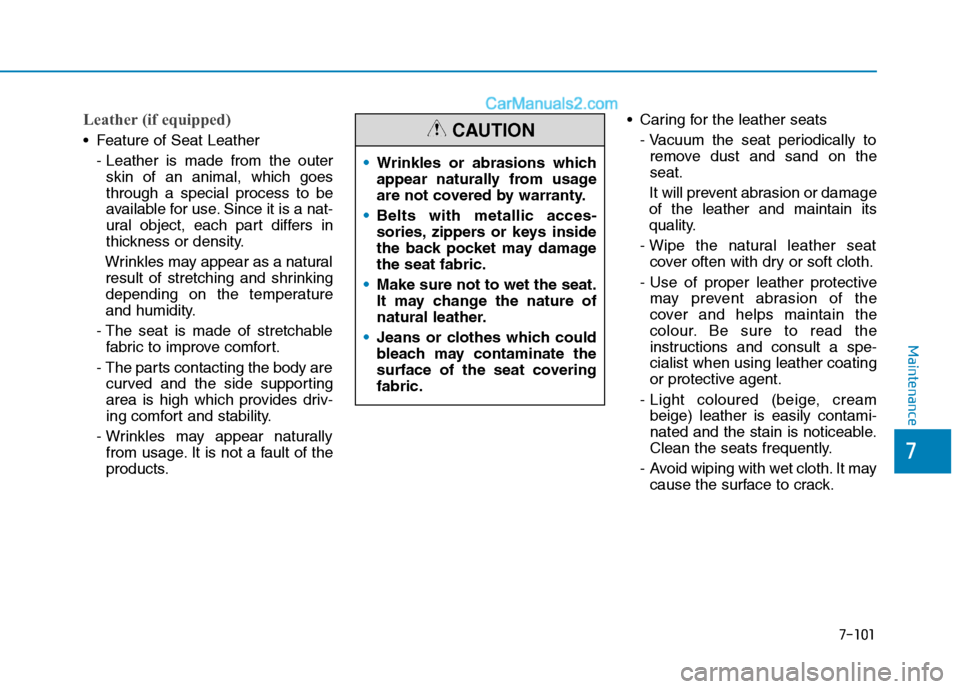
7-101
7
Maintenance
Leather (if equipped)
Feature of Seat Leather
- Leather is made from the outer
skin of an animal, which goes
through a special process to be
available for use. Since it is a nat-
ural object, each part differs in
thickness or density.
Wrinkles may appear as a natural
result of stretching and shrinking
depending on the temperature
and humidity.
- The seat is made of stretchable
fabric to improve comfort.
- The parts contacting the body are
curved and the side supporting
area is high which provides driv-
ing comfort and stability.
- Wrinkles may appear naturally
from usage. It is not a fault of the
products. Caring for the leather seats
- Vacuum the seat periodically to
remove dust and sand on the
seat.
It will prevent abrasion or damage
of the leather and maintain its
quality.
- Wipe the natural leather seat
cover often with dry or soft cloth.
- Use of proper leather protective
may prevent abrasion of the
cover and helps maintain the
colour. Be sure to read the
instructions and consult a spe-
cialist when using leather coating
or protective agent.
- Light coloured (beige, cream
beige) leather is easily contami-
nated and the stain is noticeable.
Clean the seats frequently.
- Avoid wiping with wet cloth. It may
cause the surface to crack. Wrinkles or abrasions which
appear naturally from usage
are not covered by warranty.
Belts with metallic acces-
sories, zippers or keys inside
the back pocket may damage
the seat fabric.
Make sure not to wet the seat.
It may change the nature of
natural leather.
Jeans or clothes which could
bleach may contaminate the
surface of the seat covering
fabric.CAUTION
Page 618 of 637
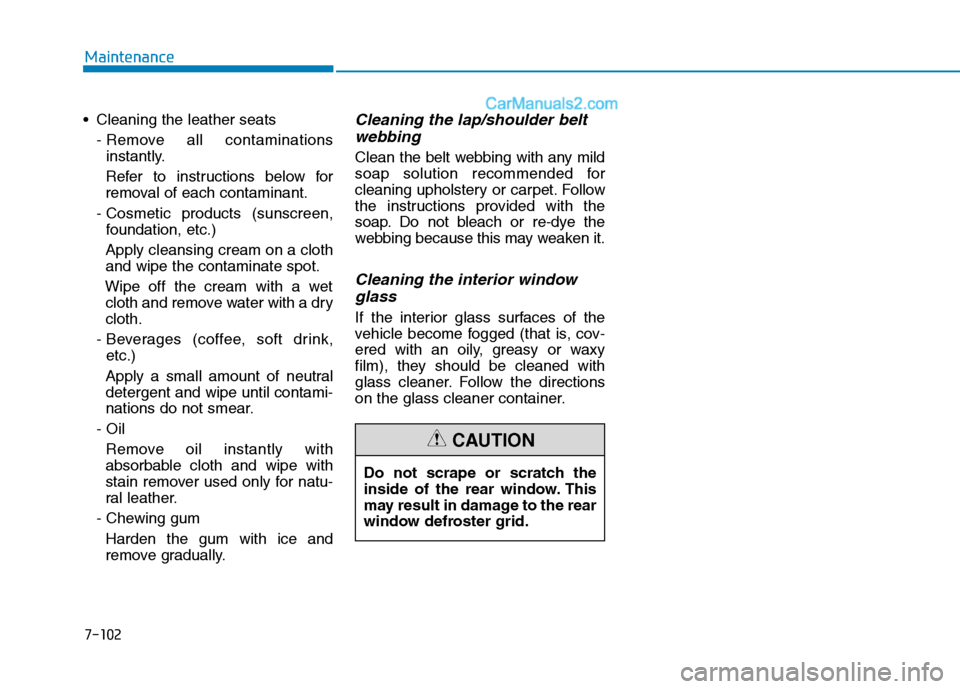
Cleaning the leather seats
- Remove all contaminations
instantly.
Refer to instructions below for
removal of each contaminant.
- Cosmetic products (sunscreen,
foundation, etc.)
Apply cleansing cream on a cloth
and wipe the contaminate spot.
Wipe off the cream with a wet
cloth and remove water with a dry
cloth.
- Beverages (coffee, soft drink,
etc.)
Apply a small amount of neutral
detergent and wipe until contami-
nations do not smear.
- Oil
Remove oil instantly with
absorbable cloth and wipe with
stain remover used only for natu-
ral leather.
- Chewing gum
Harden the gum with ice and
remove gradually.Cleaning the lap/shoulder belt
webbing
Clean the belt webbing with any mild
soap solution recommended for
cleaning upholstery or carpet. Follow
the instructions provided with the
soap. Do not bleach or re-dye the
webbing because this may weaken it.
Cleaning the interior window
glass
If the interior glass surfaces of the
vehicle become fogged (that is, cov-
ered with an oily, greasy or waxy
film), they should be cleaned with
glass cleaner. Follow the directions
on the glass cleaner container.
7-102
Maintenance
Do not scrape or scratch the
inside of the rear window. This
may result in damage to the rear
window defroster grid.
CAUTION